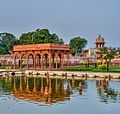Portal:Gardening
The Gardening Portal

Gardening is the process of growing plants for their vegetables, fruits, flowers, herbs, and appearances within a designated space. Gardens fulfill a wide assortment of purposes, notably the production of aesthetically pleasing areas, medicines, cosmetics, dyes, foods, poisons, wildlife habitats, and saleable goods (see market gardening). People often partake in gardening for its therapeutic, health, educational, cultural, philosophical, environmental, and religious benefits. Gardening varies in scale from the 800 hectare Versailles gardens down to container gardens grown inside. Gardens take many forms, some only contain one type of plant while others involve a complex assortment of plants with no particular order. (Full article...)
Horticulture is the art and science of growing plants. This definition is seen in its etymology, which is derived from the Latin words hortus, which means "garden" and cultura which means "to cultivate". There are various divisions of horticulture because plants are grown for a variety of purposes. These divisions include, but are not limited to: gardening, plant production/propagation, arboriculture, landscaping, floriculture and turf maintenance. For each of these, there are various professions, aspects, tools used and associated challenges; Each requiring highly specialized skills and knowledge of the horticulturist. (Full article...)
General images -
Selected article -

Agroforestry (also known as agro-sylviculture or forest farming) is a land use management system that integrates trees with crops or pasture. It combines agricultural and forestry technologies. As a polyculture system, an agroforestry system can produce timber and wood products, fruits, nuts, other edible plant products, edible mushrooms, medicinal plants, ornamental plants, animals and animal products, and other products from both domesticated and wild species.
Agroforestry can be practiced for economic, environmental, and social benefits, and can be part of sustainable agriculture. Apart from production, benefits from agroforestry include improved farm productivity, healthier environments, reduction of risk for farmers, beauty and aesthetics, increased farm profits, reduced soil erosion, creating wildlife habitat, less pollution, managing animal waste, increased biodiversity, improved soil structure, and carbon sequestration. (Full article...)Selected image
Related portals
Did you know -
- ... that none of the actors in Poppy Garden, a film depicting a father and son's struggle for survival during the Colombian conflict, had previously acted in a film?
- ... that the Akinada Tobishima Kaido, an island-hopping road, was named after its resemblance to stepping stones in a garden?
- ... that Bulandshahr's ornate Garden Gate was built on the site of a "filthy" drainage ravine?
- ... that in 2023, a sculpture garden in Praunheim displayed abstract works by Hans Steinbrenner from different periods of his life, and corresponding works by his friends and students?
- ... that the Shakespeare garden in Wessington Springs, South Dakota, was the first of its kind in the state?
- ... that popular garden plants like malfurada often escape from cultivation and become invasive?
- ... that Ardwall House has a garden ornament in the form of an early mediaeval Pictish slab inscribed with a Celtic cross?
- ... that the uncommon Florida lichen species Gyalectidium yahriae was named after Rebecca Yahr of the Royal Botanic Garden Edinburgh in Scotland?
Things you can do
- This list is transcluded from the tasks list page. To edit the list, click here
 |
Here are some tasks awaiting attention:
|
WikiProjects
Topics
Categories
Associated Wikimedia
The following Wikimedia Foundation sister projects provide more on this subject:
-
Commons
Free media repository -
Wikibooks
Free textbooks and manuals -
Wikidata
Free knowledge base -
Wikinews
Free-content news -
Wikiquote
Collection of quotations -
Wikisource
Free-content library -
Wikiversity
Free learning tools -
Wiktionary
Dictionary and thesaurus


































































































